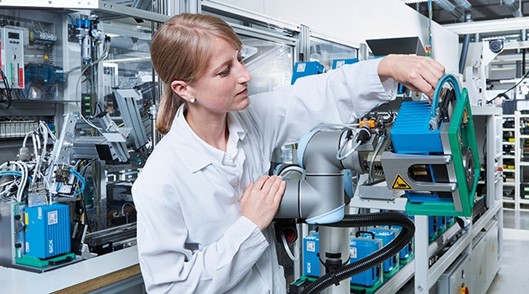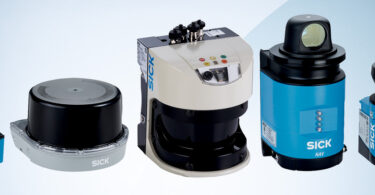Flexible collaboration between humans and robots for safe and efficient automation
For many years, the use of robots in production was an image you encountered primarily in the automotive industry. Behind high fences, giant robot arms assembled heavy parts. Now, robots have changed, and they perform a wide range of tasks. Fanny Platbrood, Head of Strategic Product Management for Safety Systems and Services at SICK, explains what is required for human-robot collaboration.
“While they were predominantly used in the 1970s for handling heavy loads, we have observed a remarkable development over time. Robots have become smaller, more maneuverable, more flexible and can perform tasks at high rates. This has expanded their fields of application enormously,” said Platbrood. “Robots can be found in nearly every industry these days. Especially where precision is required, for example in the electronics industry where ultrasmall components are processed.”
New Opportunities Generated by Collaboration
When the first collaborative robot came on the market in 2008, it opened a completely new dimension in the collaboration of humans and machines.
“That was a groundbreaking innovation. Firstly, because collaborative robots are truly able to work with and around humans. And secondly, because they became a lot easier to operate,” said Platbrood. “The programming of robots is now similar to the use of apps on a smartphone. You don't necessarily need to be a technical specialist to program a robot these days. This lowers one of the biggest hurdles to the use of robots.”
Although fences have become less desirable when collaborating with lightweight robots, safety continues to remain an important issue. Effective provisions for robot applications, particularly collaborative ones, should not scare people off, but create trust. The person interacting with the robot should have no concerns about their safety. A risk assessment at the beginning is essential.
“We need to consider the entire system when doing so, right through to the end effector and the object it is transporting. If, for example, the robot is carrying something with a sharp edge and the end of the robot arm is not adequately protected, this can lead to irreversible injuries. The prerequisite for a ‘trusting’ collaboration is a risk assessment and the risk reduction measures derived from it,” said Platbrood, “A requirement for collaborative robot applications is that they have a smart means of protecting the end effector in order to greatly minimize the risk of injury. That would be an absolute game changer because it would allow many further collaborative applications.”
Benefits of Safety – Human-Robot Collaboration!
When we look at the entire process, we see potential for optimization. In human-robot collaboration, it is necessary to continuously monitor speeds. When a person approaches the robot, it needs to reduce its speed, perhaps even come to a complete stop. The most common solutions are based on safety laser scanners. However, programming the protective fields can become technically complex as the number of fields increases and doesn't provide any flexibility in implementation. Platbrood believes that 3D safety cameras could offer a solution approach for monitoring the entire robot application and thereby continuously recording the movements.
“In the end, the solution will probably involve a combination of different technologies in a system that is easy to integrate and configure. If we succeed with this step, there will be no pre-programmed workflows for robots, instead they will make decisions independently based on the environment and requirements,” she said.
Platbrood is convinced that this development is not too far away and adds that digitalization has already fundamentally changed the way we collaborate with robots and will continue to change it:
“Digitalization allows much more dynamic developments. We will then no longer be talking about robot applications, the productivity of which we can increase through safe flexible workflows, but rather about a complete network of collaborative and stationary robots, where AGVs, AMRs and humans work together in an overall system. The transmission of data between machines would then allow self-determined workflows appropriate to the situation. Safety in this context no longer means having to accept the tradeoff of slower processes because, for example, this creates wait times. No, it’s safety that actually makes all of this collaboration possible. And that for me is the holy grail of human-robot collaboration: Creating Safe Productivity – We want to increase the productivity of our customers through safe, efficient processes.”
Want more information about SICK solutions? Contact a SICK representative today!







